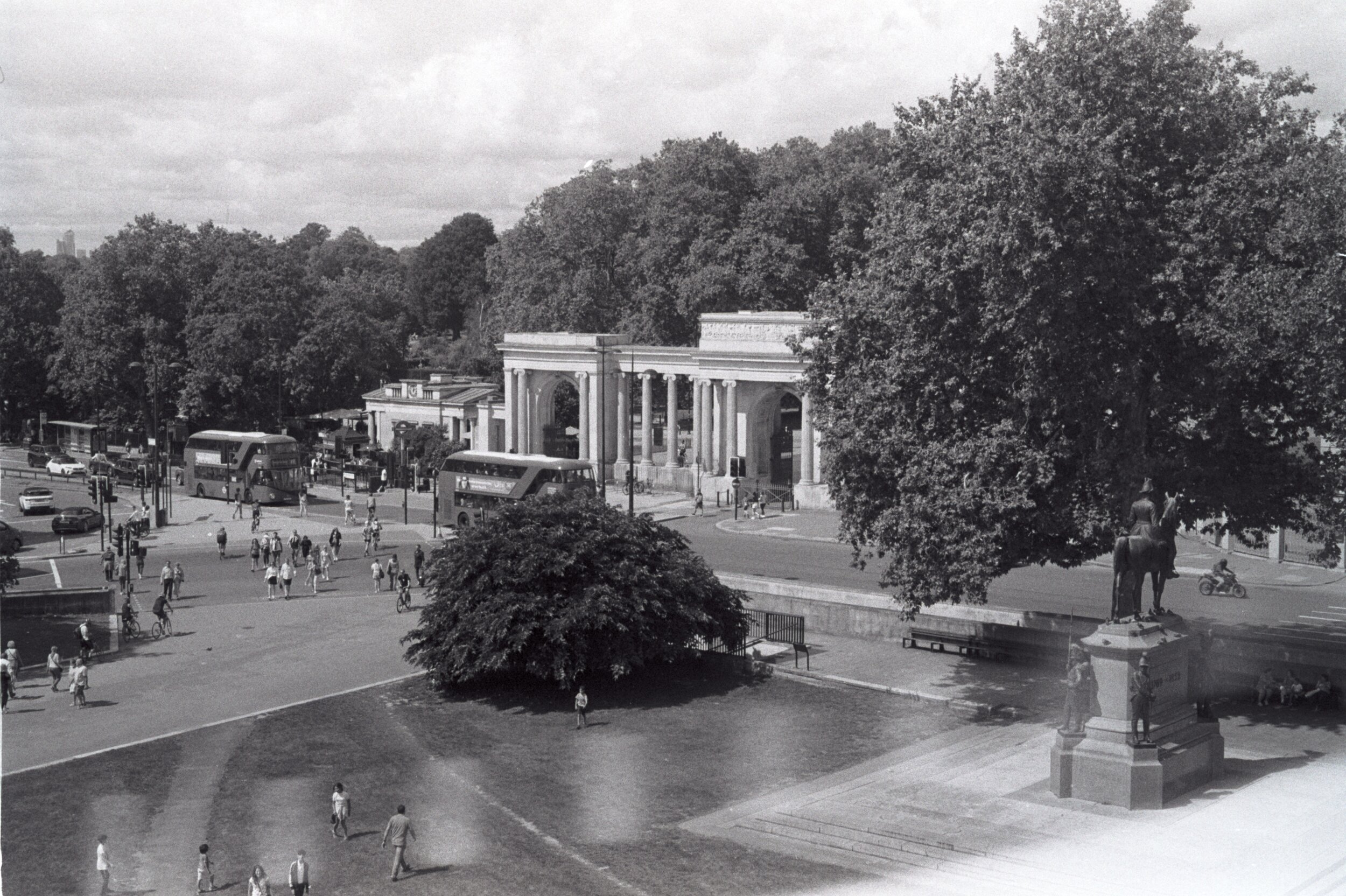
A Giant Wellington
The Story of Wellington, his giant boot and a huge horse
Statues... Always a controversial topic (see my article here) but I am pleased to say that the controversy isn’t new. This is the story of how a poorly attended committee meeting resulted in one of the largest statues ever built, a threat by the most famous of Britain’s soldiers to retire from public life and the explanation as to why a small hill in Aldershot is home to an enormous statue made of French cannon.
In the 1820s, Hyde Park Corner became one of the main entrances to London and a gateway was erected which still remains as a formal entrance to the park. However, this rather unremarkable gateway was perceived as not quite up for the job and it was felt that a more splendid arch ought to be constructed at this juncture, particularly given that it was effectively the entrance to the surrounding area of Buckingham Palace which was in the process of a thorough redesign.
The Wellington Statue today
Unsurprisingly, the project ran over budget and the treasury refused to finish the building to the standard required but luckily, at this point, it was realised that the arch might have a secondary use that could kill two birds with one stone. A number of committees had been created in the 1830s to honour the two great heroes of the Napoleonic War. The first, the Nelson Memorial Committee created Nelson’s column (despite some considerable controversy being created by the failure of the much-promised lions – shameless plug for a future article). The second committee, the Wellington Memorial Committee did not have such a successful run.
One of the key members was John Wilson Croker MP. Croker is famous as a literary writer and critic but one that dragged politics directly into some of his attacks on those he was reviewing. More entertainingly though, he was also one of the founding members of the Athenaeum Club and, when the members voted to create an icehouse for cold drinks at the great expense of £2,000, he ignored them entirely and instead spent the money commissioning the famous replica of the Parthenon statues that still sits around the Athenaeum to this day. This led to the famous criticism, “I'm John Wilson Croker, I do as I please. They ask for an Ice House, I give them—a Frieze".
Croker took a similar approach to the Wellington project and, whilst attending a barely quorate committee meeting in May 1838, voted for an equestrian statue of Wellington to be installed on the top of the unfinished arch. And what a statue.
The Wellington Arch (minus Wellington)
It was the largest equestrian statue ever created. Weighing 40 tons and standing almost 9 meters high, the legs had to be cast solid so as not to buckle. Even the plaster of Paris model from which the bronze was cast weighed three tons. Unbelievably, the statue was dragged in 1846 by 100 men from the workshop to Hyde Park corner on a carriage with wheels 10 feet in diameter.
It was instantly unpopular. A minor issue was that the horse depicted was supposed to be Wellington’s trusty steed, Copenhagen but the horse had died earlier in 1836 (supposedly because he had been indulging in too many “dainties” like “sponge cakes, bath buns and chocolate creams”) and was therefore not available for modelling. Many felt it wasn’t very accurate and, somewhat surprisingly this created some ill feeling (people felt that the head looked more like a “pig’s snout”…)
Of more concern was the sheer size of the statue. It was enormous. It’s clear from the contemporary photos of the time that the statue made the whole arch look ludicrous and a clamour began almost immediately for it to be removed. The architect of the arch, Decimus Burton, actually left money in his will for the statue’s removal. Queen Victoria also hated it and, in response, the government began exploring the possibility of its removal.
It’s worth adding at this point that, unlike Nelson, Wellington was very much alive during this period and actually lived next to the arch at One London (Apsley House). I have real admiration for Wellington but he was notoriously tetchy about his accolades (he and Napoleon waged something of a PR war after Waterloo). After hearing that his statue was to be removed, Wellington declared that this would be a personal insult and a mark of royal disfavour that would compel him to resign all of his public posts and retire from public life. Such was Wellington’s formidable (and extremely hard won) reputation that such an idea was abandoned while the Duke was still alive.
Ultimately though, the statue fell to a much more mundane concern than public opinion. By the 1870s, Hyde Park Corner was a complete bottle neck and there was a need to shift the arch a few hundred meters back to where it sits today. The new positioning is slightly odd and old photographs make more sense of the original location next to the ceremonial gateway to Hyde Park. The opportunity was used to remove the statue and shift it to the military town of Aldershot where it sits overlooking a park. For many years, neglected and somewhat sad, it has been restored by the excellent people at the Friends of the Aldershot Military Museum. It is still too large. Even for the hill it sits on.
The Wellington Arch sat empty for many years until a much more reasonably sized Quadriga was installed at the top in 1912. It’s now an English Heritage site and well worth a climb to the top to sneak a look into the Queen’s back garden. When there, spare a thought for Wellington’s massive statue and, perhaps, when visiting the South coast, stop and take a look. Just don’t comment on Copenhagen’s face…

